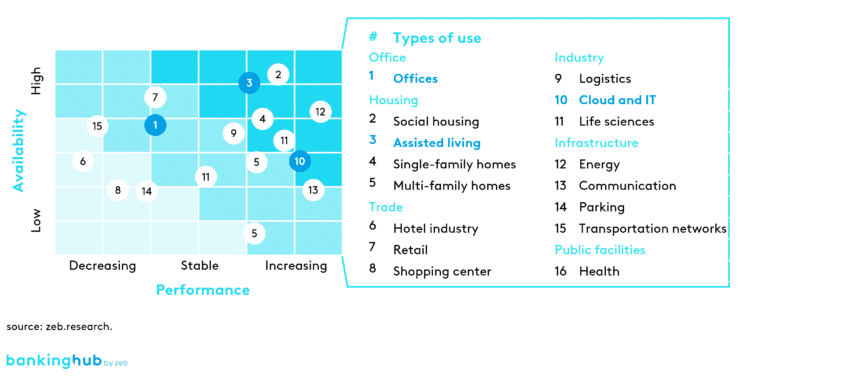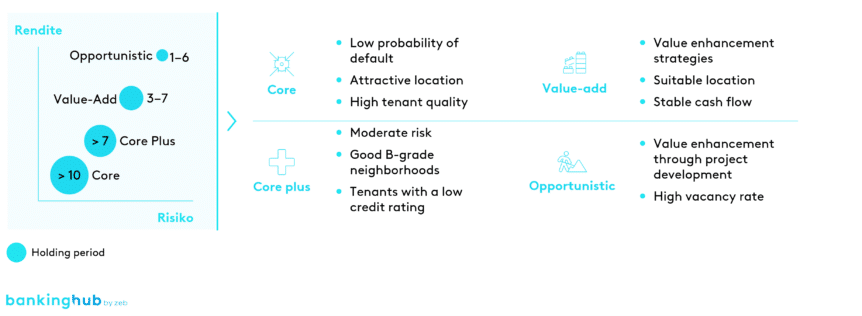Dimensions of the strategic orientation of the zeb.solution framework
The first article in our series highlighted the challenges real estate fund managers are currently facing as well as key levers for successfully realigning the business and operating models of real estate managers. These levers can be thematically grouped into the following three dimensions (see Figure 1):
- Dimension A) Products and services,
- Dimension B) Investment forms and vehicles,
- Dimension C) Operating model (value addition).
In this second article, we will analyze the potential opportunities and risks arising from long-term socio-demographic, technological and social developments – so-called “megatrends” – for certain types of use in the real estate market. These promising segments are expected to particularly benefit from the ongoing structural changes.
At the same time, we will examine the classic and higher-risk investment strategies – core, core plus, value-add and opportunistic – and highlight their individual advantages and disadvantages as well as the associated requirements and capacity needs. Our analysis will take into account the changing market conditions and the increasing importance of sustainable investment approaches.
BankingHub-Newsletter
Analyses, articles and interviews about trends & innovation in banking delivered right to your inbox every 2-3 weeks
"(Required)" indicates required fields
Dimension A) Products and services
Geographical diversification
Most real estate funds from the DACH region, such as open-ended mutual funds, concentrate their investments in Germany, France and the UK[1]. However, the fund managers would be well-advised to also consider investments outside of Europe. Such an expansion of their investment focus would allow them to not only diversify their overall portfolio – in many cases, they could even achieve higher returns through targeted investments in emerging regions.
To this end, they need to build up expertise on the legal framework, regulatory requirements and tax aspects of the regions they plan to invest in. Moreover, specific language skills and a local network are necessary to identify interesting investment objects outside the public market. In sum, geographical diversification always requires a precise analysis of local circumstances. Especially outside of Europe, barriers to market entry must not be ignored, including, for example, the maximum share of real estate properties that foreign investors are allowed to hold or regulations that require them to enter into partnerships (e.g. joint ventures) with local companies before they are allowed to buy any real estate at all.
According to our European forecast, Eastern Europe[2] will be the region with the highest increase in transaction volume between 2023 and 2025 with a growth rate of 18%[3], compared to a 6% growth rate[4] in Central and Western Europe in the same period. On a global scale, our 2023–2025 forecast suggests Asia as another attractive market with an investment volume increase of 16%.[5] Targeted real estate investments in this region may thus yield considerable earnings – however, significant risks such as transparency regarding beneficial ownership must also be carefully analyzed.
Expansion by new types of use
Across all industries, the current times are characterized by profound socio-demographic, technological and social changes, which will have long-term effects on the way we organize our societies. These far-reaching changes also have an impact on the attractiveness of different types of use, which opens up opportunities for expanding or repositioning business activities pertaining to new types of use that are likely to benefit greatly from the megatrends.
To identify such opportunities in the real estate sector, we have evaluated and compared the availability and income potential of different types of use in a comprehensive analysis (see Figure 1).
In the following section, we will take a closer look at three of these types of use.
Cloud and IT
The success of digitalization heavily relies on the availability of highly specialized microchips, which play an important role for various technological applications such as Web 3.0 and artificial intelligence, as well as the comprehensive provision of cloud-based services for both businesses and private consumers. Moreover, there is a high need for data and computing centers, while the demand for chip fabs is even increasing. In the short and medium term, substantial EU subsidies are expected to cover the extensive investment requirements throughout Europe, meaning that government measures will significantly boost the earnings potential of this type of use.
When it comes to data centers, Frankfurt, London, Amsterdam, Paris and Dublin are currently the most important hubs in Europe, although other major cities, including German ones such as Munich and Berlin, are also seen as promising future alternatives. However, it should be noted that data centers currently require a lot of energy and are therefore susceptible to future regulatory requirements concerning the sources from which they procure their energy.
In the medium term, data centers that are operated sustainably with electricity from renewable energy sources and make efficient use of the large amounts of waste heat generated will attract particular interest. What lends this type of use a special appeal is predictable and continuous income from the usually long-term rental agreements, the extension of which is also very likely because it requires a lot of effort and money to relocate a data center. All of these factors make this type of use particularly attractive for institutional real estate investors aiming to diversify their portfolio.
Assisted living
Assisted living, as part of the overarching category of healthcare real estate, includes both care facilities and residential offers for independent living for the elderly. This type of use is developing very dynamically due to the advancing age of the baby boomer generation, which will result in an increasing demand for care and nursing services for elderly people. Even in the short term, the rising average age of the population is already leading to growing demand for assisted living. However, what really makes this trend stand out is its longevity and high stability.
When investing in this type of real estate, it is important to bear in mind that full, revenue-optimizing utilization of the facilities can be hampered by a shortage of skilled staff. Moreover, the properties should be selected in a very targeted manner, particularly in view of rising energy costs. What is attractive from an investor’s perspective is that this type of investment does not only fulfill an important societal function, but also has a relatively low correlation with other asset classes. Investments in assisted living are therefore also advantageous from a diversification point of view.
Offices
At the latest since the advent of “new work” models – in particular those enabled through digitalization or resulting from the changing requirements of the modern working world – the demand for traditional office premises has been stagnating or even declining. Even though some large employers are returning to more on-premise work, this has no significant impact on the overall trend towards remote work. Existing office buildings and structures are often not suitable for new work processes that are geared towards cooperation and communication. However, extensive office renovations or conversions, which would be necessary to meet the new modern work requirements, are often not economically viable.
Converting offices, especially in urban areas, into residential properties is a more promising approach. Such transformations make it possible to meet the housing demands in highly frequented areas while reducing vacancies. In addition, larger, older office buildings allow for new housing concepts that combine different types of use, such as residential quarter or mixed-use projects, which are less dependent on economic cycles and therefore attractive for real estate investors.
Realigning the investment strategy
When determining an investment strategy, the main focus should be on weighing up the return potential against the risk profile. The preferred holding period of the properties and the fundamental question of whether potentially increased risks can be tolerated must also be taken into account. The investment strategies can be divided into the four well-known categories core, core plus, value-add and opportunistic, whose typical features are summarized below.
Core and core plus currently dominate the investment strategies of large real estate fund managers who pursue long-term investment strategies and tend to be risk-averse. Core and core plus strategies are therefore a stability-oriented, albeit potentially lower-yielding, option in uncertain times. However, in today’s market, almost all real estate fund managers pursue these traditional strategies, so they no longer represent a unique selling point or an innovative advantage over other investors.
The current market conditions, i.e. more expensive construction financing and rising wage and material costs, have led to a noticeable reduction in construction activity. This makes value-add and opportunistic strategies, which focus on real estate properties in average or poor condition, unattractive for the time being. Both strategy types require extensive investment: while value-add strategies typically aim to renovate properties or make them suitable for other types of use, opportunistic approaches often require extensive refurbishment measures. The current economic situation and the associated high level of risk makes it more difficult to make these projects financially viable.
On the other hand, in the context of sustainability, new work and the long-term trend towards combining housing, working and living (construction of residential quarters), there is greater demand for investors pursuing value-add and opportunistic strategies. Measures to make real estate fit for the future include comprehensive ESG-compliant refurbishments, transformations of offices into residential buildings and the development of new urban concepts. All of these measures require real estate fund managers to commit to them and to expand their expertise.
In future, well-thought-out value-add and opportunistic strategies can represent a relevant advantage over competitors. However, these strategies require extensive expertise, qualified specialists and a higher risk appetite, as both strategy types are typically associated with considerable uncertainty. Through the targeted integration of value-add and opportunistic strategies, supported by appropriate expertise, networking and risk management, real estate fund managers can strengthen their position in the market and benefit from the long-term advantages of these approaches.
Conclusion and outlook
For real estate fund managers, the current volatile market environment presents both challenges and opportunities. The willingness to develop flexible and innovative business and investment strategies will be decisive for how well they can benefit from the expected market recovery.
In view of the uncertainties on the real estate market, fund managers will need to adapt their strategies and recognize new investment opportunities at an early stage in order to ensure long-term success. This requires them not only to analyze existing trends, but also to proactively react to market changes. Investments in up-and-coming regions and innovative types of use that benefit from long-term megatrends such as digitalization and demographic change are particularly promising.
By realigning their strategy and proactively adapting it to changing market conditions, real estate fund managers can not only master the current challenges, but also ensure stability and sustainable growth in the future.
In the next article, we will take a closer look at different operating models and the capacities, functions and technologies required for realigning a business and investment strategy. Among other things, we will focus on the special requirements for holding structures in infrastructure investments and examine the necessary expertise and other prerequisites, e.g. with regard to project developments, value-add and opportunistic investment strategies.






